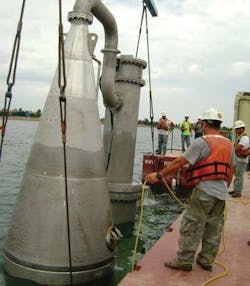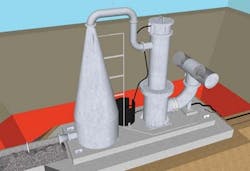Raw water drawn from deep reservoirs or lakes can acquire undesirable taste, odor, and elevated manganese issues, especially in autumn, when seasonal stratification and turnover allow decaying plant and organic residue to reach the lower level hypolimnion and further deplete already limited oxygen.
Scope
Even with its enviable reputation for producing high quality drinking water, Denver Water shared the seasonal problems confronted by many utilities that use surface impoundments as their raw water source. The problems were most pronounced at Denver Water’s 250 million gallon per day (mgd) Marston Water Treatment Plant, which
relies on source water drawn from a single outlet 43 feet below the surface of the 621-acre Marston Reservoir. Denver Water needed a cost-effective and environmentally sensitive way to eliminate recurring seasonal changes and subsequent customer complaints about water quality.
Solution
Denver Water invested in hypolimnetic oxygenation, using a submerged downflow contact oxygenation system known as a Speece Cone. Beginning in June, before the onset of seasonal reservoir stratification, an ECO2 Speece Cone submerged at the bottom of the 66-foot-deep reservoir pumps oxygenated water into the 20- to 30-foot-thick hypolimnion zone. The system breathes new life into the anoxic layer of water as an alternative to chemicals, costly filtration, or complicated and environmentally risky bypass schemes.
At one side of the 8-foot-diameter, 18-foot-high system, a stainless steel pump column houses a 35-HP Flygt submersible pump. Water Technology Group, a Xylem factory representative, supplied the heavy duty Flygt pump—the only moving part of the entire system—which delivers a 3,200 GPM fl ow at a head of 23 feet.
“The Speece Cone has the advantage of allowing the use of pure oxygen,” said Kelly DiNatale, PE, who led the project. “Conventional compressors pump air with an oxygen content of approximately 21 percent, meaning that nearly five times the volume of air must be pumped compared to delivering pure oxygen. The relatively low efficiency of the air compressor for a conventional aeration system becomes an important consideration when evaluating life cycle operations and maintenance costs.”
“In the Marston installation, the system uses a 35-horsepower Flygt pump to achieve an extremely high percentage of efficiency in oxygen transfer. You move five times the volume of oxygen compared to a conventional aeration system.”
Result
The system began initial operation at 100 percent output (approximately 2,000 lbs/day), which represented a delivered cost of $92/day in liquid oxygen. At that amount, the oxygenation reversed the Dissolved Oxygen (DO) depletion and increased the level at the bottom of the reservoir to a pre-stratification level of 10 mg/l.
After four weeks of operation, the system feed rate was reduced to 75 percent output, or 1500 lbs/day, reducing the expense to $69/day. DO levels remained high, with a concentration in the hypolimnion of 10 mg/l on July 1 compared to normal early July concentrations of 2 mg/l.
The diffused, sidestream delivery of the oxygenated water occurs at 6 feet above the sediment bed. This minimizes turbulence, suppresses nutrient releases, and maintains stratification of the reservoir while producing a high level of dissolved oxygen directly above the sediment. The system does not destratify the lake, thus minimizing the mixing of any algae from the surface and maintaining a desirable cool temperature in the hypolimnion.
Editor's Note: Scranton Gillette Communications and the SGC Water Group are not liable for the accuracy, efficacy and validity of the claims made in this piece. The views expressed in this content do not reflect the position of the editorial teams of Water & Wastes Digest, Water Quality Products and Storm Water Solutions.

